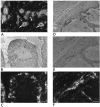H19 overexpression in breast adenocarcinoma stromal cells is associated with tumor values and steroid receptor status but independent of p53 and Ki-67 expression
- PMID: 9811352
- PMCID: PMC1853398
- DOI: 10.1016/S0002-9440(10)65748-3
H19 overexpression in breast adenocarcinoma stromal cells is associated with tumor values and steroid receptor status but independent of p53 and Ki-67 expression
Abstract
In a previous study we described the expression of the H19 gene by in situ hybridization (ISH) in normal breast and in benign or malignant breast tumors (Dugimont T, Curgy JJ, Wernert N, Delobelle A, Raes MB, Joubel A, Stehelin D, Coll J: Biol Cell 1995, 85:117-124). In the present work, 1) we extend the previous one to a statistically useful number of adenocarcinomas, including 10 subclasses, 2) we provide information on the precise ISH localization of the H19 RNA by using, on serial tissue sections, antibodies delineating specifically the stromal or the epithelial component of the breast, and 3) we consider relationships between the H19 gene expression and various clinicopathological information as tumor values (T0 to T4), grades, steroid receptors, lymph node status, and molecular features as the p53 gene product and the Ki-67/MIB1 protein, which is specific to proliferating cells. Data indicate that 1) in 72.5% of studied breast adenocarcinomas an overall H19 gene expression is increased when compared with healthy tissues, 2) the H19 gene is generally overexpressed in stromal cells (92.2%) and rarely in epithelial cells (2.9% only), 3) an up-regulation of the H19 gene is significantly correlated with the tumor values and the presence of both estrogen and progesterone receptors, and 4) at the cellular level, the H19 gene demonstrates an independent expression versus accumulation of both the p53 protein and the Ki-67/MIB-1 cell-cycle marker.
Figures


References
-
- Poirier F, Chan CTJ, Timmons PM, Robertson EJ, Evans MJ, Rigby PWJ: The murine H19 gene is activated during embryonic stem cell differentiation in vitro at the time of implantation in the developing embryo. Development 1991, 113:1105-1114 - PubMed
-
- Rachmilevitz J, Goshen R, Ariel I, Schneider T, de Groot N, Hochberg A: Parental imprinting of the H19 gene. FEBS Lett 1992, 309:25-28 - PubMed
-
- Douc-Razy S, Coll J, Barrois M, Joubel A, Prost S, Dozier C, Stéhelin D, Riou G: Expression of the human fetal BAC/H19 gene in invasive cancers. Int J Oncol 1993, 32:753-758 - PubMed
-
- Lustig O, Ariel I, Ilian J, Lev-Lehman E, de Groot N, Hochberg A: Expression of the imprinted gene H19 in the human fetus. Mol Reprod Dev 1994, 38:239-246 - PubMed
Publication types
MeSH terms
Substances
LinkOut - more resources
Full Text Sources
Medical
Research Materials
Miscellaneous

